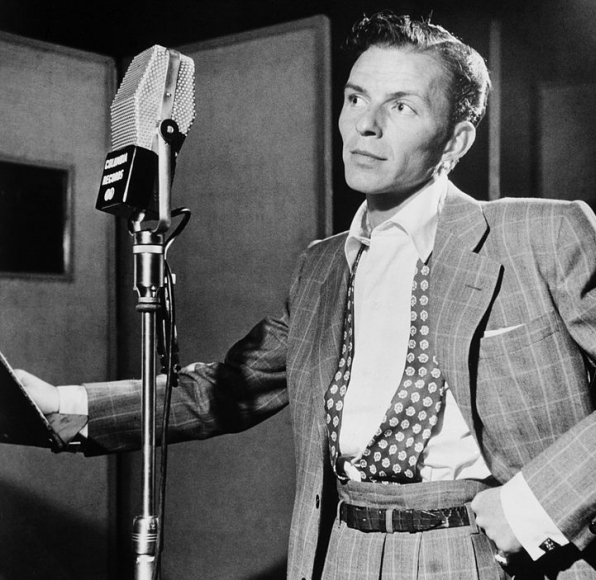
When TV producer Norman Lear was serving with the U.S. Army in Italy during World War II, he and all his buddies hated Frank Sinatra. Their wives and girlfriends back home were romantically obsessed with Frankie, but Lear and his friends considered Sinatra to be a draft-dodger. (He was excused from going into the armed forces due to a punctured eardrum.) Lear’s complaint is one of many unflattering comments about Sinatra in the HBO documentary about his life and music.
Half of the population, it seemed, loathed him while the other half was in thrall.
That was Sinatra’s polarizing position at that time. This young and controversial Sinatra was more interesting than the hip sophisticate of his later years. And he was unique.
There had been star musical performers before him — Al Jolson, Bing Crosby, Benny Goodman — but none of them were sex objects for teen girls. As the object of this delirium, Sinatra was a forerunner of Elvis Presley.
This four-hour show was directed by Alex Gibney, a respected documentarian who recently produced a scathing exposé of Scientology. He used excerpts from TV shows and movies, newspaper clippings, audio interviews and the singer’s own words as recorded by his family and by radio stations. Gibney framed all this within Sinatra’s supposed-farewell concert of 1951, for which Ol’ Blue Eyes selected 11 songs to tell the story of his career. Gibney used these songs as guideposts to examining Sinatra’s life.
The documentary surprises us with its lengthy inclusion of negative aspects of Sinatra. This included an arrest for rape, his avoidance of military service, connections with mobsters, infidelity and sexism (referring to women as “broads” and “dolls”), and a phase when his wife Ava Gardner and songwriter Jimmy Van Heusen described him as a drunk.
Friends and family members do offer explanations, but Gibney’s choice to dredge up these incidents is impressive. This is no hero-worshiping hagiography. The program is far from a sugar-coating.
Gardner tells how Sinatra pulled a gun and threatened to shoot himself. But the program omits one graphic illustration of how far Sinatra fell before making a comeback. Insecure and desperate in 1953, he attempted suicide by putting his head in an oven. He was rescued by Manie Sacks, whom I knew when I was a teenager and he was vice president of NBC and RCA Victor Records. Sacks never talked on tape about the incident which, no doubt, is why Gibney omitted it from his documentary. Around this time, Sinatra also attempted suicide by slashing his wrist.
Most impressive is Gibney’s concentration on the early part of Sinatra’s life. Younger viewers know his later songs “Come Fly with Me” and “My Way.” But if you’re a female who grew up in an earlier era, you remember Frankie for romantic ballads in which his light, high voice suggested innocence, as did his skinny physique. Many women wanted to mother him, others to sleep with him, and the passions of those early fans are revealed as we see and hear from bobby-soxers who screamed and swooned for Sinatra.
A superstar in 1942, he was thought to be washed up by 1952. He made a comeback by tackling dramatic roles in film, starting with 1953’s From Here to Eternity, for which he won a Best Supporting Actor Oscar. The newly self-confident Sinatra bragged, “I get knocked on my ass, but I’m getting up.” His understanding of suffering and his resilience made him a hero. Earlier, males had resented him; now men said they’d like to be him.
Sinatra claimed “I’ve been a saloon singer all my life and I’ve become an expert in saloon songs that cause men to cry in their beers in little bars because they’re in trouble with their girls.” That’s not really true. The program demonstrates his background as a radio performer who moved up to be the “boy singer” with Harry James’s band and then Tommy Dorsey’s, leading to a movie career. So the saloon singer was an invention. I’m disappointed that Gibney failed to point this out and weave it into the narrative where contradictions are a prominent part of the Sinatra story.
The most perplexing incongruity is in the area of race relations. Sinatra was a powerful denouncer of racial bigotry early in his career and he befriended Sammy Davis Jr. But later, in his Las Vegas days, Sinatra made Davis the butt of racist jokes. Sinatra also was a prominent campaigner for John F. Kennedy but resented the Kennedys snubbing him because of his mob ties, so he became a supporter of rightwingers. All of this makes Sinatra a fascinating subject for this examination.
Read other reviews on The Cultural Critic